2004 DODGE GRAND CARAVAN ECU
[x] Cancel search: ECUPage 14 of 397

chip (transponder) embedded into them. Only keys that
have been programmed to the vehicle can be used to start
and operate the vehicle.
The Sentry Key Immobilizer System does not need to be
armed or activated. Operation of the system is automatic
regardless of whether or not the vehicle is locked or
unlocked. During normal operation, the Theft Alarm/
Immobilizer Light will come on for three (3) seconds
immediately after the ignition switch is turned on for a
bulb check. Afterwards, if the bulb remains on, this
indicates a problem with the electronics.
If the bulb begins to flash after the bulb check, this
indicates that an invalid key has been used to start the
vehicle. Both of these conditions will result in the engine
being shut off after two (2) seconds of running.
Keep in mind that a key which has not been programmed
is also considered an invalid key even if it is cut to fit the
ignition lock cylinder for that vehicle. If the Theft Alarm/Immobilizer Light comes on during
normal vehicle operation (vehicle has been running for
longer than 10 seconds), a fault has been detected in the
electronics and the vehicle should be serviced as soon as
possible.
NOTE:
² The Sentry Key Immobilizer System is not compatible
with remote starting systems. Use of these systems
may result in vehicle starting problems and loss of
security protection.
² Exxon/Mobil Speed Pass,Ÿ additional Sentry Keys, or
any other transponder equipped components on the
same keychain will not cause a key-related (transpon-
der) fault unless the additional part is physically held
against the ignition key being used when starting the
vehicle. Cell phones, pagers, or other RF electronics
will not cause interference with this system.14 THINGS TO KNOW BEFORE STARTING YOUR VEHICLE
Page 18 of 397

WARNING!² For personal security and safety in the event of an
accident, lock the vehicle doors as you drive as
well as when you park and leave the vehicle.
² When leaving the vehicle always remove the key
from the ignition lock, and lock your vehicle. Do
not leave children unattended in the vehicle, or
with access to an unlocked vehicle. Unsupervised
use of vehicle equipment may cause severe per-
sonal injuries and death.
Power Door Locks Ð If Equipped
A power door lock switch is on each front door trim
panel. Use this switch to lock or unlock the doors. If you press the power door lock switch while the key is
in the ignition, and any front door is open, the power
locks will not operate. This prevents you from acciden-
tally locking your keys in the vehicle. Removing the key
or closing the door will allow the locks to operate. A
chime will sound if the key is in the ignition switch and
a door is open, as a reminder to remove the key.18 THINGS TO KNOW BEFORE STARTING YOUR VEHICLE
Page 29 of 397

² Avoid high impacts against the door stop when open-
ing the door. This is very important when your vehicle
is parked on an incline as the door will slide faster in
the downhill direction.
² There is a hold-open latch that is activated when the
sliding door is fully opened. This latch will keep your
sliding door open on any incline. To close the sliding
door after the hold-open latch is activated, you must
push the button on the inside grab handle or pull out
on the outside sliding door handle.
² Use the grab handle on the inside of the sliding door to
assist you in closing and securing the door.
Always make sure that the sliding door is fully latched
any time the vehicle is in motion. NOTE: The driver's side sliding door cannot be opened
while the fuel door is open. This feature operates only
when the sliding door is fully closed prior to opening the
fuel door.
Power Sliding Door Ð If Equipped
NOTE: The power sliding door must be unlocked before
the switches located on the trim panel, just in front of the
power sliding door will operate.
The power sliding door may be opened manually or by
using the buttons on the remote keyless entry transmitter.
Press the buttons on the remote keyless entry transmitter
twice within five seconds, to open a power sliding door.
Once the door is fully open, pressing the button twice
within five seconds a second time will close the door. THINGS TO KNOW BEFORE STARTING YOUR VEHICLE 29
2
Page 51 of 397
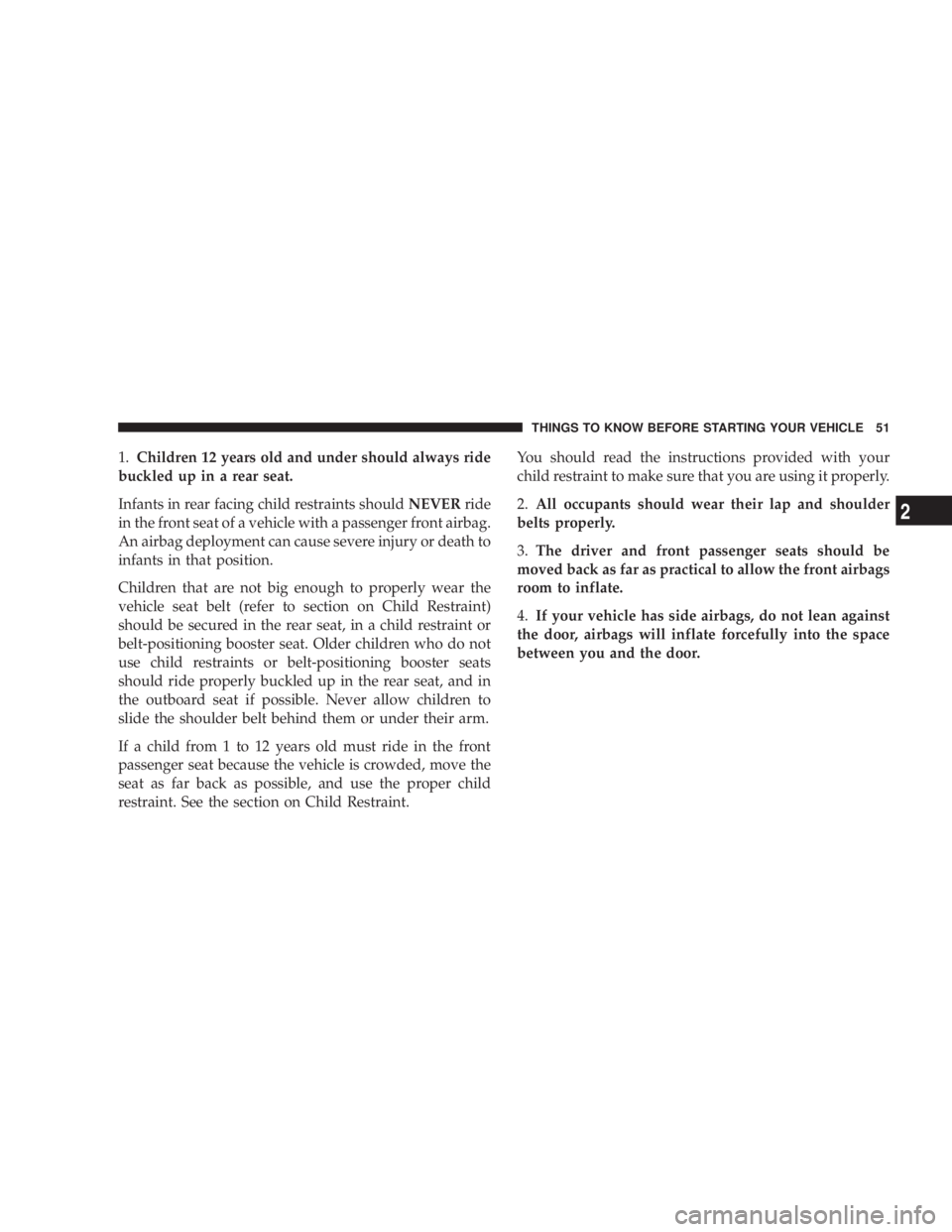
1. Children 12 years old and under should always ride
buckled up in a rear seat.
Infants in rear facing child restraints should NEVER ride
in the front seat of a vehicle with a passenger front airbag.
An airbag deployment can cause severe injury or death to
infants in that position.
Children that are not big enough to properly wear the
vehicle seat belt (refer to section on Child Restraint)
should be secured in the rear seat, in a child restraint or
belt-positioning booster seat. Older children who do not
use child restraints or belt-positioning booster seats
should ride properly buckled up in the rear seat, and in
the outboard seat if possible. Never allow children to
slide the shoulder belt behind them or under their arm.
If a child from 1 to 12 years old must ride in the front
passenger seat because the vehicle is crowded, move the
seat as far back as possible, and use the proper child
restraint. See the section on Child Restraint. You should read the instructions provided with your
child restraint to make sure that you are using it properly.
2. All occupants should wear their lap and shoulder
belts properly.
3. The driver and front passenger seats should be
moved back as far as practical to allow the front airbags
room to inflate.
4. If your vehicle has side airbags, do not lean against
the door, airbags will inflate forcefully into the space
between you and the door. THINGS TO KNOW BEFORE STARTING YOUR VEHICLE 51
2
Page 58 of 397
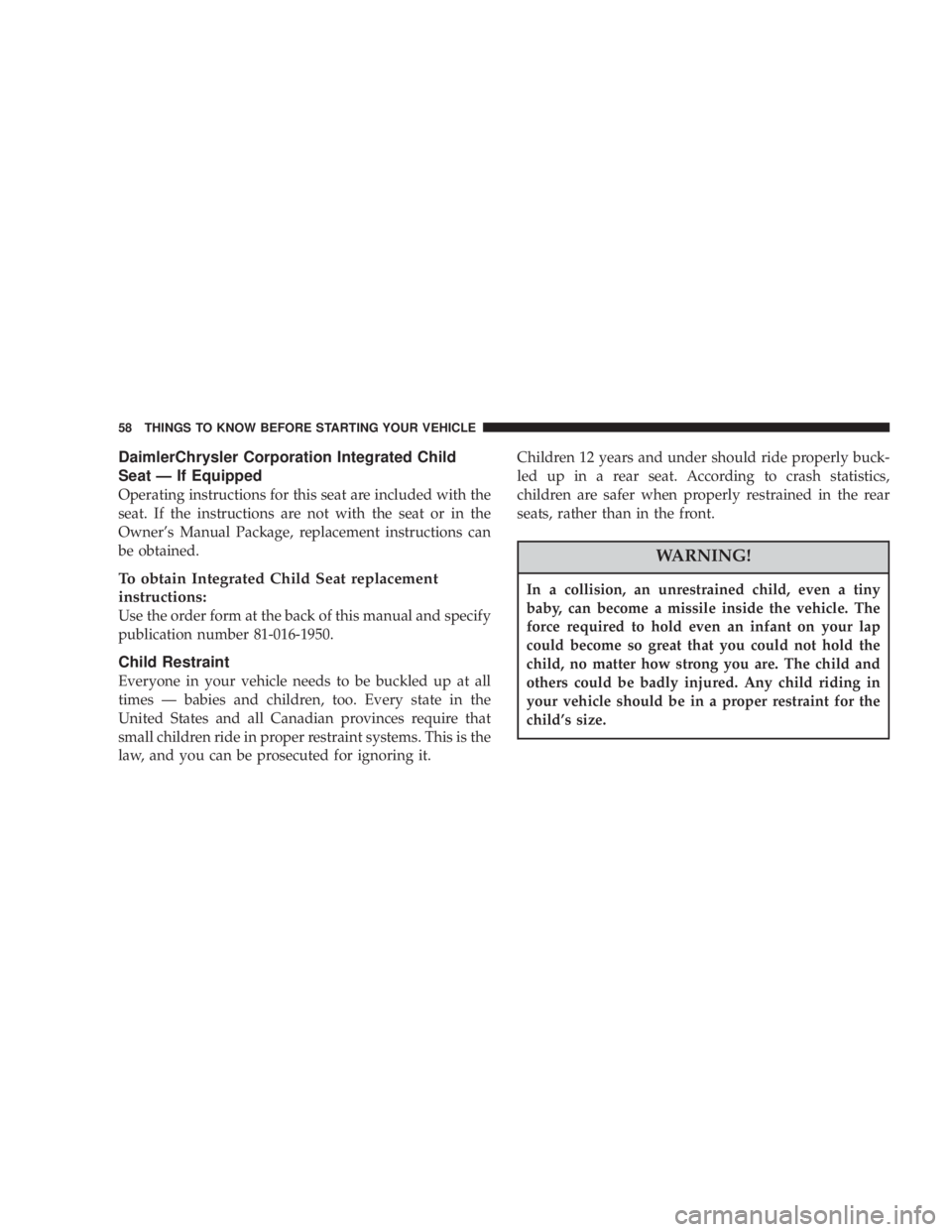
DaimlerChrysler Corporation Integrated Child
Seat Ð If Equipped
Operating instructions for this seat are included with the
seat. If the instructions are not with the seat or in the
Owner's Manual Package, replacement instructions can
be obtained.
To obtain Integrated Child Seat replacement
instructions:
Use the order form at the back of this manual and specify
publication number 81-016-1950.
Child Restraint
Everyone in your vehicle needs to be buckled up at all
times Ð babies and children, too. Every state in the
United States and all Canadian provinces require that
small children ride in proper restraint systems. This is the
law, and you can be prosecuted for ignoring it. Children 12 years and under should ride properly buck-
led up in a rear seat. According to crash statistics,
children are safer when properly restrained in the rear
seats, rather than in the front.
WARNING!In a collision, an unrestrained child, even a tiny
baby, can become a missile inside the vehicle. The
force required to hold even an infant on your lap
could become so great that you could not hold the
child, no matter how strong you are. The child and
others could be badly injured. Any child riding in
your vehicle should be in a proper restraint for the
child's size.58 THINGS TO KNOW BEFORE STARTING YOUR VEHICLE
Page 61 of 397
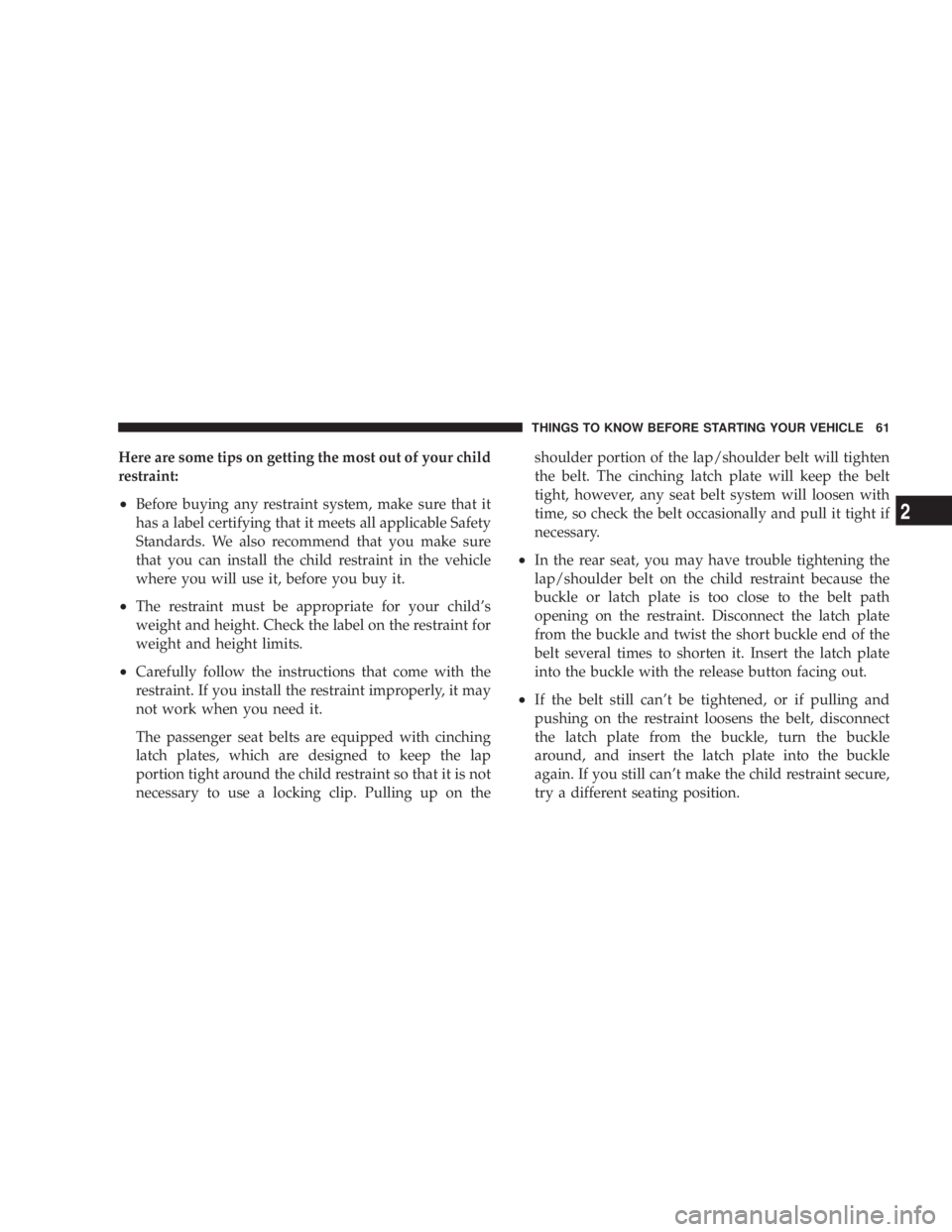
Here are some tips on getting the most out of your child
restraint:
² Before buying any restraint system, make sure that it
has a label certifying that it meets all applicable Safety
Standards. We also recommend that you make sure
that you can install the child restraint in the vehicle
where you will use it, before you buy it.
² The restraint must be appropriate for your child's
weight and height. Check the label on the restraint for
weight and height limits.
² Carefully follow the instructions that come with the
restraint. If you install the restraint improperly, it may
not work when you need it.
The passenger seat belts are equipped with cinching
latch plates, which are designed to keep the lap
portion tight around the child restraint so that it is not
necessary to use a locking clip. Pulling up on the shoulder portion of the lap/shoulder belt will tighten
the belt. The cinching latch plate will keep the belt
tight, however, any seat belt system will loosen with
time, so check the belt occasionally and pull it tight if
necessary.
² In the rear seat, you may have trouble tightening the
lap/shoulder belt on the child restraint because the
buckle or latch plate is too close to the belt path
opening on the restraint. Disconnect the latch plate
from the buckle and twist the short buckle end of the
belt several times to shorten it. Insert the latch plate
into the buckle with the release button facing out.
² If the belt still can't be tightened, or if pulling and
pushing on the restraint loosens the belt, disconnect
the latch plate from the buckle, turn the buckle
around, and insert the latch plate into the buckle
again. If you still can't make the child restraint secure,
try a different seating position. THINGS TO KNOW BEFORE STARTING YOUR VEHICLE 61
2
Page 62 of 397
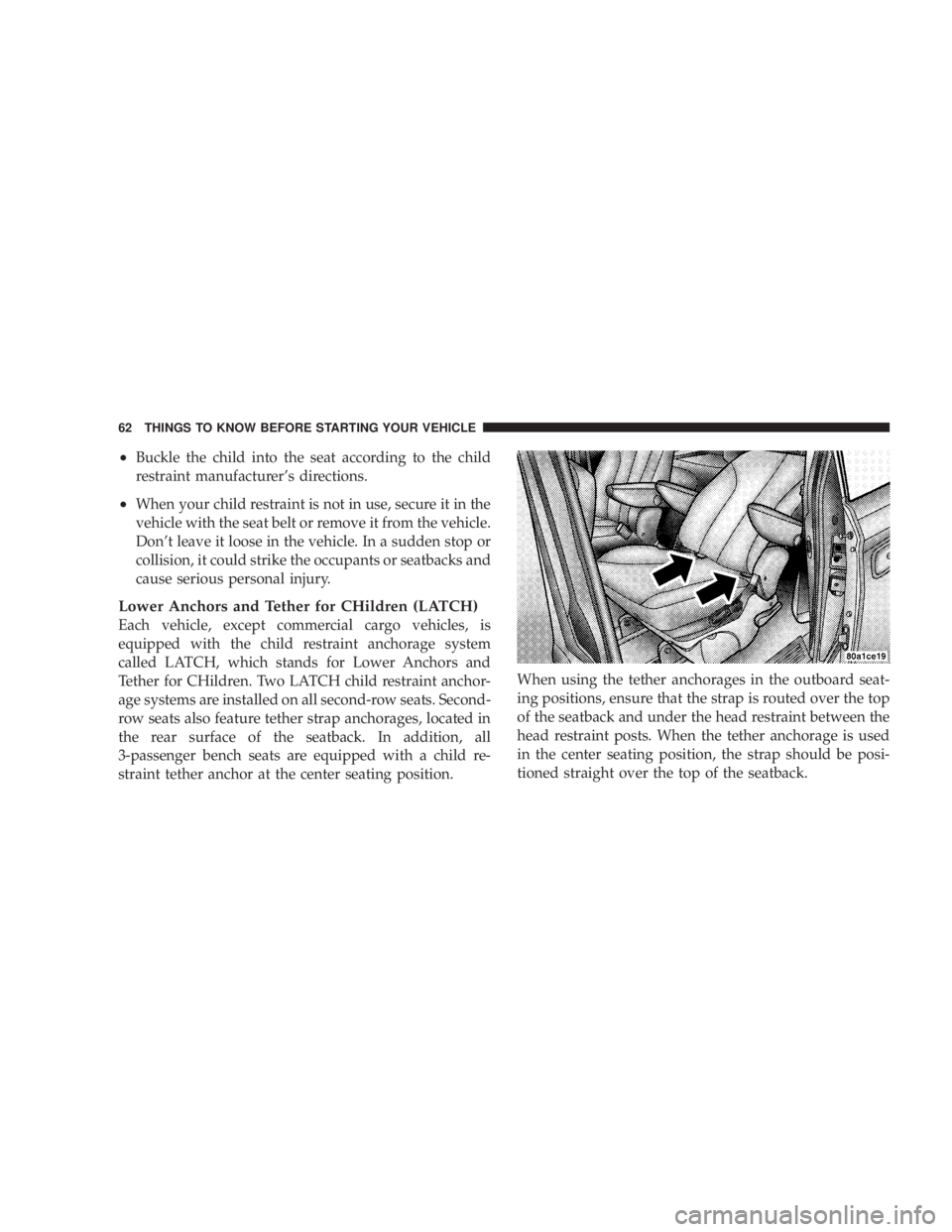
² Buckle the child into the seat according to the child
restraint manufacturer's directions.
² When your child restraint is not in use, secure it in the
vehicle with the seat belt or remove it from the vehicle.
Don't leave it loose in the vehicle. In a sudden stop or
collision, it could strike the occupants or seatbacks and
cause serious personal injury.
Lower Anchors and Tether for CHildren (LATCH)
Each vehicle, except commercial cargo vehicles, is
equipped with the child restraint anchorage system
called LATCH, which stands for Lower Anchors and
Tether for CHildren. Two LATCH child restraint anchor-
age systems are installed on all second-row seats. Second-
row seats also feature tether strap anchorages, located in
the rear surface of the seatback. In addition, all
3-passenger bench seats are equipped with a child re-
straint tether anchor at the center seating position. When using the tether anchorages in the outboard seat-
ing positions, ensure that the strap is routed over the top
of the seatback and under the head restraint between the
head restraint posts. When the tether anchorage is used
in the center seating position, the strap should be posi-
tioned straight over the top of the seatback.62 THINGS TO KNOW BEFORE STARTING YOUR VEHICLE
Page 63 of 397
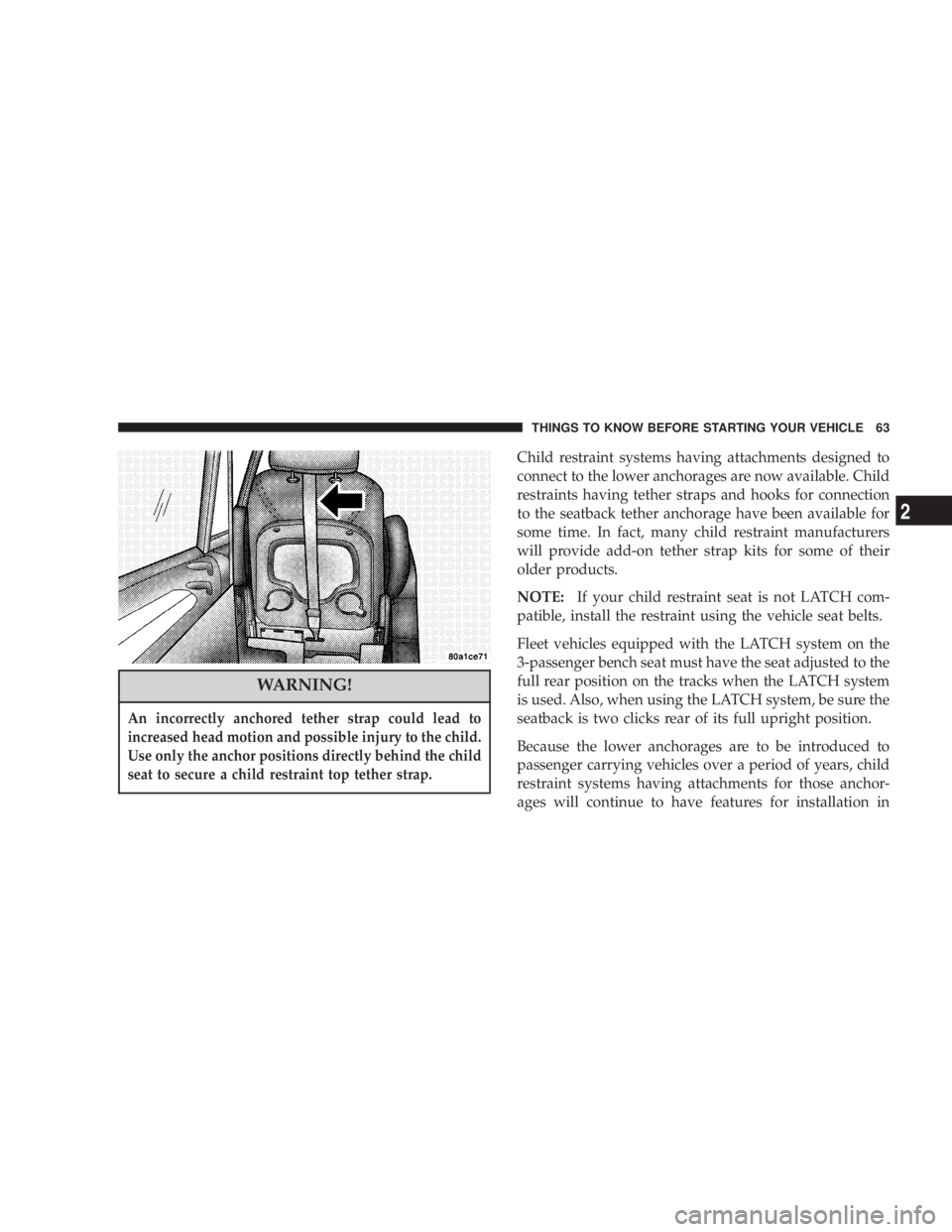
WARNING!An incorrectly anchored tether strap could lead to
increased head motion and possible injury to the child.
Use only the anchor positions directly behind the child
seat to secure a child restraint top tether strap. Child restraint systems having attachments designed to
connect to the lower anchorages are now available. Child
restraints having tether straps and hooks for connection
to the seatback tether anchorage have been available for
some time. In fact, many child restraint manufacturers
will provide add-on tether strap kits for some of their
older products.
NOTE: If your child restraint seat is not LATCH com-
patible, install the restraint using the vehicle seat belts.
Fleet vehicles equipped with the LATCH system on the
3-passenger bench seat must have the seat adjusted to the
full rear position on the tracks when the LATCH system
is used. Also, when using the LATCH system, be sure the
seatback is two clicks rear of its full upright position.
Because the lower anchorages are to be introduced to
passenger carrying vehicles over a period of years, child
restraint systems having attachments for those anchor-
ages will continue to have features for installation in THINGS TO KNOW BEFORE STARTING YOUR VEHICLE 63
2